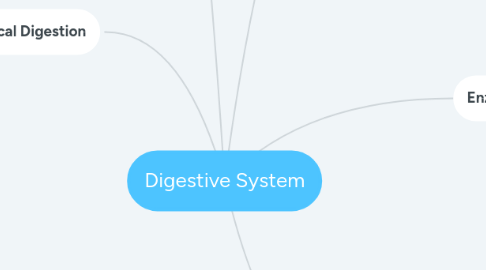
1. Breaks down large food molecules into small molecules that are absorbed into the blood to be transported tot he body cells.
2. Chemical Digestion
2.1. Mouth
2.1.1. Contains salivary amylase in the saliva, digest starch (substrate) into maltose (product)
2.2. Oesophagus where peristalsis
2.2.1. A rhythmic, wave-like muscular contraction of the walls of the gut
2.2.2. Allows food to mix with digestive juices and move food along the gut
2.2.3. Muscles in front of the food relaxes to allow food to enter while the muscles behind contracts to push food forward
2.2.4. Occurs along the entire gut
2.3. Stomach
2.3.1. Gastric gland secrete gastric juice which contains protease and hydrochloride acid
2.3.2. Protease digest proteins into polypeptide
2.4. Pancrea
2.4.1. Produces Pancreatic Juice
2.4.2. Amylase
2.4.3. Protease
2.4.4. Lipase
2.5. Liver
2.5.1. Produces bile which emulsify large fat droplets into smaller fat droplets
2.5.2. Increasing surface area to volume ratio
2.5.3. Increasing surface area to volume ratio to spread up chemical digestion of fat molecules by lipase
2.6. Small Intestine
2.6.1. Lipids are digested by lipase in the pancreatic juice and intestinal juice to form fatty acids and glycerol
2.6.2. Amylase in pancreatic juice digests starch into maltose
2.6.3. In the intestinal juice, maltase is digested in maltose into glucose
2.6.4. Protease in pancreatic juice digests protein into polypeptide
2.7. Large Intestine
2.7.1. Some of the remaining water and mineral salts in the undigested food (faeces) are absorbed
3. Large food molecules
3.1. Cannot pass through the cell surface membrane of cells, which is partially permeable.
3.1.1. Starch
3.1.1.1. (complex carbohydrate)
3.1.1.2. End product: Glucose
3.1.1.3. Enzymes: Salivary Amylase (Starch in mouth), Maltase (Maltose in Small Intestine & Pancreatic Juice)
3.1.2. Fats/Lipids
3.1.2.1. Made up of a glycerol molecule and 3 fatty acid molecules
3.1.2.2. End product: Glycerol + Fatty acid molecules
3.1.2.3. Enzyme: Lipase
3.1.3. Proteins
3.1.3.1. Made up of many different amino acid molecules
3.1.3.2. End product: Amino Acid
3.1.3.3. Enzyme: Protease
4. Enzymes
4.1. Biological molecule that speeds up chemical reactions in living cellss
4.2. Specific in their action
4.3. Remain chemically unchanged at the end of the reaction
4.4. Speed up chemical reactions in digestions
5. Small Intestine
5.1. It is about 6 metres long and coiled to provide sufficient time for absorption of digested food molecules
5.2. Many blood capillaries are present to help carry away absorbed nutrients away quickly to maintain a steep concentration gradient
5.2.1. This allows the rate of absorption of digested food molecules to remain high as there is still a lower concentration of digested food molecules
5.3. Villi
5.3.1. Finger-like projection increases the surface area for absorption
5.3.2. One-cell thick epithelium makes it faster for the digested food molecules to pass through to the bloodstream
5.3.3. Glucose and amino acids are absorbed by diffusion and active transport into the blood capillaries in the small intestine
5.3.4. Fats are absorbed into he lacteals in the small intestine
5.3.5. Water and mineral salts are absorbed into the blood capillaries in the small intestine and colon (large intestine)
